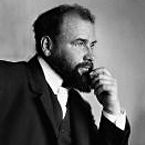painter, draughtsman and graphic artist, son of an engraver, funder and important representative of the Vienna Secession.
1876-1883 studied at the Vienna School of Arts and Crafts with J. V. Berger and F. Laufberger, from 1879 worked with his brother Ernst K. and Franz Matsch .
The paintings created in this period were partly decorative, partly influenced by Hans Makart and were designed for public buildings (theatre of Reichenberg 1882/83, Bukarest 1885, Rijeka 1885, Karlsbad 1886; Hermesvilla in Lainz, Vienna 1885, staircases of the Vienna Burgtheater 1886-1888, staircase of the Kunsthistorisches Museum in Vienna 1890/91).
After the death of his brother Ernst in 1892, K. was commissioned to paint the ceiling frescoes (The Faculties) in the Aula of the University of Vienna together with F. Matsch (1894). In 1905 he cancelled the order, as the presentation of his "Philosophy" and of his "Medicine" had provoked harsh protests.
Secession
In 1897 K. was a founding member of the Vienna Secession, which he chaired until his resignation in 1905. His style was subject to significant changes, he broke with the academic ideal and his later works were characterised by intensive colours, frequent use of golden backgrounds, ornamental design of surfaces and sometimes strong symbolism. As the main representative of the Vienna Secession K. was in a very influential position among the artists and persons engaged on the cultural sector of the monarchy and was a popular portrait painter of Viennese society (S. Knips, A. Bloch-Bauer etc.). In 1902 he created the Beethoven Frieze for the Secession.
Close friendship with the founders of the Wiener Werkstätte (1903) Josef Hoffmann and Kolo Moser .
In 1905 K. designed his sketch of the marble frieze of the Palais Stoclet in Brussels, which was executed in 1911 by the workshop of L. Forstner.
Klimt also became famous for his landscapes and, in particular for his extensive graphic work, which shows a marked erotic element. K.´s work constitutes a link between Historicism and modern tendencies, such as the art of Egon Schiele , and he therefore holds a key position in Austrian art history.
